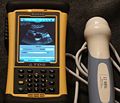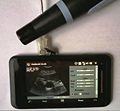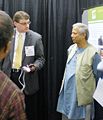Difference between revisions of "Cell Phone SDK"
| Line 150: | Line 150: | ||
=== Other Images=== | === Other Images=== | ||
<gallery perrow=5> | <gallery perrow=5> | ||
| + | Image:bladder.png|Bladder | ||
Image:eye.png|Eye | Image:eye.png|Eye | ||
Image:eye2.png|Eye 2 | Image:eye2.png|Eye 2 | ||
| − | + | Image:fetalhead.png|Fetal Head | |
| + | Image:fetus|Fetus - 23 Weeks | ||
| + | Image:jugular.png|Carotid and Jugular | ||
| + | Image:kidney.png|Kidney | ||
| + | Image:val.png|Vascular Access | ||
</gallery> | </gallery> | ||
Revision as of 19:11, 7 December 2009
Contents
The World's First Ultrasound Machine Based on a Cell Phone
| Working under a Microsoft Research grant, Cell Phone as a Platform for Healthcare, we modified commercially available USB ultrasound probes to work with a smart phone and developed the SDK presented, here. Microsoft Research has awarded us a second grant to begin some field trials with DMD patients at Washington University in St. Louis School of Medicine. |
- We presented our work at the first mHealth Summit in Washington D.C. at the end of October.
- First fetal images taken at Washington University in St. Louis Medical School: Fetal Images
- The SDK has been released.
- Craig Mundie, Microsoft's Chief Research and Strategy Officer, talks about cell phone ultrasound at the 2009 Microsoft Research Faculty Summit.
- A presentation was given at Microsoft Research's Faculty Summit on July 13, 2009. We will also be doing live demos at this meeting.
- This work was presented at Microsoft Research TechFest 2009 on February 25-26.
- Was shown at the 2009 World Health Care Congress in Washington D.C., April 14-16. The poster is here.
- Microsoft Resaerch also published a white paper on this technology.
- This work was presented at TEPR+ in February, 2009: Presentation
SDK Release
Version 2.51 has been released to the public. Source code is now available. It is released under a BSD-style license by Washington University in St. Louis.
An installer for the binary is also available and must be installed before working with the source code; this is to properly install the drivers and resources referenced by the application.
For help/discussion of this code, please use the help forum on the SourceForge.net project page.
The source may be accessed via SVN as documented here. Using SVN on a Windows machine is easy and we suggest downloading TortoiseSVN for your platform if you don't already use SVN via some other method.
- MobileUS on SourceForge.net
- Binary installer will install MobileUS on your Windows Mobile 6.1 or higher smartphone. It also includes several sample cine files so you can load them and see what they system can do. This will run on any Windows Mobile 6.1 phone, even if it does not have a USB host port.
In the News
Blogs
- Dave's Blog and Twitter and Facebook
Videos
Full Length Videos
- CNBC Street Smarts Interview
- NBC news coverage
- First Fetal Images New
- Toshiba TG01 Demo
- High quality Palm Treo 800w Demo
- Demo on a Rugged Hand-Held --- Another, but higher resolution
- Demo - A complete demo of two phones
- First Demo
- Tissue Phantom - This is a simple phantom image of a series of pins and a few cyst-like structures. The phantom is old and dried out, but it gives you a sense of the capabilities of the system.
- Carotid Artery - A demo showing the carotid artery being imaged on the cell phone.
- Tissue Phantom - A demo using a standard tissue phantom.
Tutorials
As some demo units are now in the field, here are two videos that are short tutorials on the phone/probe/software (V2.4x) combination. Sorry about the poor quality video, but I think they are still useful. I'll redo these with a better camera in a bit.
Images
All of the following images may be used with proper credit given. If no credit is stated below the image, the image is in the public domain.
Example Phones
Example Probes
Example Applications
Fetal Images
Other Images
- Fetalhead.png
Fetal Head
- Fetus
Fetus - 23 Weeks
- Jugular.png
Carotid and Jugular





























